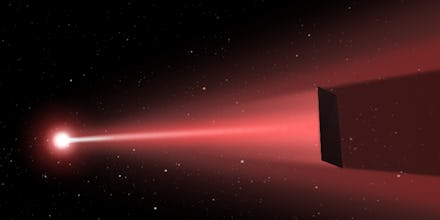NASA's Breakthrough Laser Propulsion System Could Send Ships to Mars in Just Days

It might sound like science fiction, but we already know how to make objects move at near light speed. Physicists do it all the time inside particle accelerators, where they accelerate particles to relativistic speeds just a small fraction below the speed of light (about 186,000 miles per second).
But when we try to reach these speeds on a macro scale, we run into all kinds of problems. Things like spacecraft are really heavy, especially when they're loaded down with fuel for long trips, and it's difficult to accelerate them to really fast speeds.
Now researchers are saying a new kind of laser-based propulsion would eliminate the need for fuel and could accelerate spacecraft up to 26% of the speed of light. At that blistering pace, a tiny space probe could get to Mars in just 30 minutes. And it could travel four light years to our nearest star, Alpha Centauri, in just 15 years.
Researchers say eventually, with a scaled up version of laser propulsion, a full-sized, 100-kilogram spacecraft could get to Mars in just a few days.
For comparison, right now it takes around four to eight months to get to Mars with our current technology. It took 35 years for the Voyager 1 spacecraft to reach the edge of our solar system. It's only traveling at about 0.006% of the speed of light, according to Popular Science.
If we ever want to become interstellar travelers, that sluggish speed simply won't cut it.
"As remarkable as this [is,] we will never reach even the nearest stars with our current propulsion technology in even 10 millennium," Philip Lubin, a cosmologist at the University of California Santa Barbara, writes in a paper titled "A Roadmap to Interstellar Flight."
So Lubin has proposed a laser system called photonic propulsion, in which spacecraft equipped with giant laser sails could be pushed along to increasing speeds with a powerful laser.
But instead of relying on one giant, ultra-powerful laser like the one on the Death Star, which are too impractical to build, Lubin is proposing a series of laser amplifiers that can sync up multiple lasers and combine them into one powerful beam.
The good news, Lubin notes, is that all of this technology already exists. We just need to start testing and developing it.
"There is no known reason why we cannot do this," Lubin says in a video explanation of laser propulsion.
Right now we have laser amplifiers about the size of a textbook, but Lubin thinks a 6-square-mile array of lasers and amplifiers floating out in Earth orbit would be powerful enough to beam a gram-sized spacecraft to Alpha Centauri in 15 years. But it would still take 2,200 years to send a full-sized and fully loaded space shuttle that far, so we'd eventually need an even larger laser array, according to Popular Science.
Luckily, Lubin says the design is easily scalable.
This all sounds incredible, but the researchers have a really big problem to solve first: braking. Currently there's no way to slow down one of these spacecraft once it approaches relativistic speeds. So for now if we sent a laser-propelled probe to a distant world, it could only snap a few photos and take some preliminary data measurements as it goes flying by.
But interstellar travel isn't the only thing this laser array could do. Lubin says it might be able to protect us from asteroids and space debris.
For now the researchers don't have plans to build any of the giant arrays that would be capable of beaming a spacecraft to Mars in a few days. They'll be testing the system on a smaller scale, and hopefully we'll be able to start sending teeny-tiny space probes out to explore the universe around us.
You can hear Lubin describe photonic propulsion in the video below:
h/t Popular Science